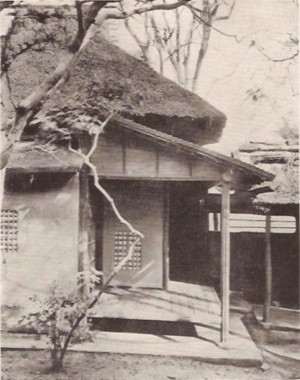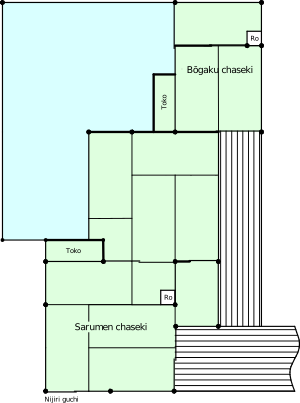Sarumen Chaseki facts for kids
The Sarumen Chaseki (猿面茶席) is a historic chashitsu, which means a traditional Japanese tea house. It is located inside Nagoya Castle in central Japan. Sarumen Chaseki and another tea house called Bōgaku Chaseki are often talked about together as Sarumen Bōgaku Chaseki (猿面望嶽茶席).
Contents
The History of Sarumen Chaseki
This special tea house was first built using materials from Kiyosu Castle. It was designed by a famous lord named Furuta Oribe (who lived from 1544 to 1615).
The Story of the "Monkey Face" Pillar
Inside the tea house, there is a special pillar called the toko-bashira. This pillar stands next to an alcove, which is a small recessed area in the room called a tokonoma. The toko-bashira is made from a unique piece of wood.
Legend says that this pillar has two wood knots near the top. A long time ago, a powerful leader named Oda Nobunaga saw the pillar. He told his friend, Toyotomi Hideyoshi, that the knots looked like Hideyoshi's face! Hideyoshi was sometimes called "little monkey" because of how his face looked. That's how this tea house got its name, "Sarumen," which means "monkey face."
From Old Treasure to New Building
The original Sarumen Chaseki was very important. It was even named a national treasure in 1936. But sadly, it was destroyed during the bombing of Nagoya in World War II. This happened during World War II.
After the war, the tea house was rebuilt in 1949. It looks very much like the original.
Tea Ceremonies Today
Today, the Sarumen Chaseki is used for different events and special gatherings. One unique tea ceremony held here honors a princess named Haruhime (who lived from 1641 to 1658). During this ceremony, a very large tea bowl, called a chawan, is used. This chawan is about 34 centimeters (13 inches) wide! It's so big that two people are needed to help drink from it.
You can also see a very good copy of the front part of the tea house at the Tokugawa Art Museum. This museum often shows a collection of beautiful Japanese tea utensils.



